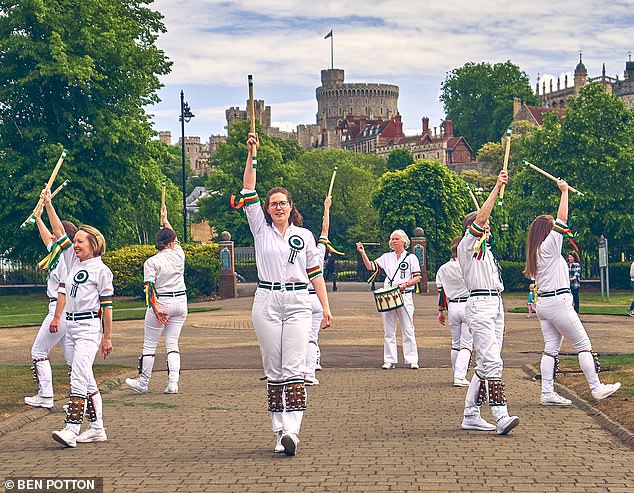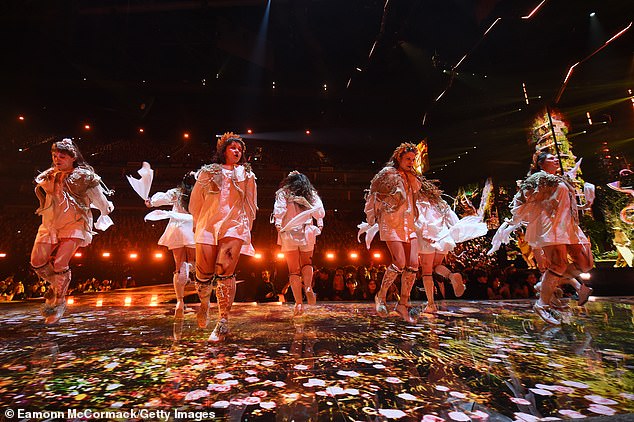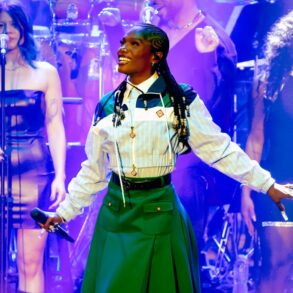How Morris dancing became hip: Maddy Fletcher joins an all-female group to shake her shin bells
Maybe it’s the bells attached to the shins or the handkerchiefs and sticks, flourished as props. Maybe it’s the fact that the dancers wear white tights. Whatever it is, morris dancing is mocked. Or at least it was, for a while.
This February, the band Wet Leg – which supported Harry Styles on tour – performed at the Brits alongside morris dancers. On TikTok, videos marked #MorrisDancing have 12.6 million views. In London, the company Folk Dance Remixed leads workshops at the Royal Opera House that combine morris moves with hip hop. The news has even reached America. In August, The New York Times published an article saying morris dancing was, finally, ‘getting a makeover’.
On a Wednesday evening, I travel from London to Gardeners Hall, a community building in Windsor, Berkshire. I’m here for a morris dancing ‘taster session’, with the group – or ‘side’, as they’re called – Windsor Morris. The first thing I see when I arrive is a huge pile of courgettes stacked on the steps outside. Gardeners Hall is, as the name suggests, surrounded by allotments.
Founded in 1974, Windsor Morris was one of the country’s first female morris sides (and initially called The Merry Wives of Windsor). According to The Morris Federation president Pauline Woods-Wilson, of the UK’s 13,600 active morris dancers, half are female. But in the 70s, women dancers were much rarer. The Morris Federation was, in fact, formed in 1975 specifically to support female sides. According to its website, this was ‘due to hostility and controversy around women dancing morris’.
Lots of people say the dance is traditionally male, but the truth is, no one really knows where it comes from. Some believe it was a pagan ritual to encourage fertility; others that its name derives from ‘Moorish’, and began in North Africa before coming to England in the crusades. There are records of male morris dancers being used as royal entertainment in 15th-century England; but there’s also evidence of women dancing morris in the 16th century. (The first morris ‘celebrity’ was, admittedly, a man – the Shakespearean actor William Kempe, who, in 1600, morris danced over 100 miles from London to Norwich. It took nine days. Nobody is quite sure why he did it.)

Today, Windsor Morris has 19 dancers in total. While five live far away – Yorkshire and Bristol – 14 regulars meet weekly to rehearse. Each pays an annual fee (dependent on their financial situation, it ranges from £35 to £75) that covers the cost of costumes and hall hire. In the summer they perform most weekends: in pubs, at festivals and weddings. Routines can involve more than 20 dances and last for one hour and 20 minutes – with a rest in between.
At events, Windsor Morris often dance with male sides, but on this Wednesday the only men are a member’s husband, who is playing the drums, a dancer from a nearby male side, who wants extra practice, and a newborn baby boy, whose mother is a morris dancer. This is her first rehearsal since giving birth and her son is duly cooed over by everyone. Throughout the two-hour session, he plays happily with a tambourine.
I’ve never done this dance before, but morris woman Shirley Dixon tells me not to worry: ‘Anyone can do it!’ So, I stick on a name label and do up my trainers. I’m in work clothes – a long dress – but everyone else is in leggings and Windsor Morris-branded T-shirts. When the side began performing in 1975, they wore shirts, flowered skirts, hats and shoes with a small heel. After one season, this uniform changed to plain skirts and heel-less shoes then, in 1978, Windsor Morris became one of the first women’s sides to dance in trousers. It was a radical change with a practical purpose: if you wear trousers, audience members can see the intricate leg work more clearly than if you wear skirts.
We begin with a warm-up, accompanied by drums and a melodeon. It’s a bit like an aerobics class – lots of arm stretches, leg kicks, hopping and jumping. We also take regular pauses, which I’m thankful for because morris dancing is quite hard work. Apparently, the movements are good for fitness and bone density.
Windsor Morris performs dances that come from different areas. I’m learning a routine from Badby, Northamptonshire, that involves jumping from one foot to the other several times, then hopping on the same foot to finish. Or, as our instructor Penny repeats, ‘Left, right, left, right, left, left, hop!’ (Written down, this sounds simple; I promise it’s not.) In a break, someone tells me, kindly and quietly, that I have perfect rhythm but I might benefit from kicking my feet forwards not backwards when I jump. This helps, but I still can’t master the final big hop. Later, while I wait at Slough station for my train home, I practise on the platform. Left, right, left, right, left, left, hop!
Eventually, we’re all given wooden sticks to hit in time to the music. I get first pick of the sticks, which inspires some – friendly – envy within the group. (These are practice sticks, not performance sticks, so some are more battered and splintery than others.) When BBC’s Countryfile filmed a programme about morris dancing in 2013, they did a risk assessment beforehand. I can see why; these sticks could be lethal. One dancer at Windsor is told to bash theirs a little less vigorously.
After an hour, I have (sort of) learnt (part of) a dance. I am clunky and out of time, but everyone is too polite to say. Instead, they tell me I am a natural. Windsor Morris are, truly, some of the kindest people on the planet.
The average age of a morris dancer is 55 and the average age of new recruits is 45.

At Windsor Morris they’re younger: six of the dancers are under 35, with the youngest 23.
Eleanor Parry started when she was 19. She’s from Lancashire but moved to Guildford in Surrey for a job in 2016. She knew no one, so a friend suggested she come to a taster session to meet locals. Parry had never danced morris before but ‘it just stuck’. Now, she is the co-squire of Windsor Morris and runs a mixed side in Southampton. ‘It’s such a joyful group of people. It’s so much fun.’
She’s right. Studies show dancing releases endorphins, reduces stress, increases energy and improves memory and mental agility.
‘Such a lot that’s aimed at youngsters nowadays seems to be very down,’ says Dixon.
‘The music’s grungy. The news is full of horrors. But there is such joy in this scene. Young people need this joy!’
Dixon started morris dancing when she was at Exeter University in 1978 after her twin sister, who had taken it up, encouraged her to do the same. ‘I’ve had the most wonderful, jolly life,’ she says, and that’s largely because of morris. ‘I was dreadfully shy when I was at school. Morris dancing opened me up and has made me a more confident person.’
Now 65, Dixon can’t dance because of her knees, so plays the drums and observes the performances instead. I ask if she’s sad that she no longer dances. ‘I had 45 years of it,’ she says. ‘So I’ve just got to be glad I had that.’
For more details go to windsormorris.org.uk
This post was originally published on this site be sure to check out more of their content.








